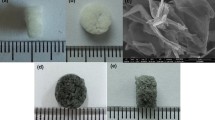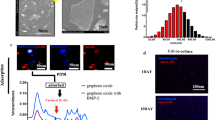Abstract
Scaffold and mesenchymal stem cell–based cartilage tissue engineering offers a favorable way for the repair and regeneration of injured cartilage. In this study, poly (ε-caprolactone) PCL scaffolds with grid-like structure having periodic lattice was manufactured by robocasting method in the presence of graphene nanoplatelets for cartilage tissue engineering applications. For this purpose, a PCL solution (20 wt%) containing pristine graphene nanopowders in the form of platelets was prepared as printing ink and it was dispensed through a nozzle at room temperature to an ethanol bath at 4 °C. The construction of porous scaffolds was made by a layer-by-layer assembly. Results revealed that graphene additions were not detrimental to deposition process and the structure of the resultant scaffolds. In vitro cell tests indicated that the prepared grid-like graphene/PCL composite scaffolds have good cytocompatibility and non-toxicity for mouse bone marrow mesenchymal stem cells. The stem cells attached and proliferated well on the scaffolds and they also demonstrated a chondrogenic differentiation in the absence of transforming growth factors.











Similar content being viewed by others
References
Ren, Z., Lan, Y., & Wang, Y. (2013). Aligned carbon nanotubes: physics, concepts, fabrication and devices (Nanoscience and Technology). Chapter 1, Introduction to carbon. Springer-Verlag, Heidelberg.
Dubey, N., Bentini, R., Islam, I., Cao, T., Neto, A. H. C., & Rosa, V. (2015). Graphene: a versatile carbon-based material for bone tissue engineering. Stem Cells International. https://doi.org/10.1155/2015/804213.
Ghuge, A. D., Shirode, A. R., & Kadam, V. J. (2017). Graphene: a comprehensive review. Current Drug Targets, 18(6), 724–733. https://doi.org/10.2174/1389450117666160709023425.
Shen, H., Zhang, L., Liu, M., & Zhang, Z. (2012). Biomedical applications of graphene. Theranostics, 2(3), 283–294. https://doi.org/10.7150/thno.3642.
Kim, T. -H., Lee, T., El-Said, W. A., & Choi, J. -W. (2015). Graphene-based materials for stem cell applications. Materials, 8, 8674–8690. https://doi.org/10.3390/ma8125481.
Singh, Z. (2016). Applications and toxicity of graphene family nanomaterials and their composites. Nanotechnology, Science and Applications, 9, 15–28. https://doi.org/10.2147/NSA.S101818.
Wang, W., Caetano, G., Ambler, W. S., Blaker, J. J., Frade, M. A., Mandal, M. P., Diver, C., & Bártolo, P. (2016). Enhancing the hydrophilicity and cell attachment of 3D printed PCL/graphene scaffolds for bone tissue engineering. Materials, 9(12), 992. https://doi.org/10.3390/ma9120992.
Liao, K. H., Lin, Y. S., Macosko, C. W., & Haynes, C. L. (2011). Cytotoxicity of graphene oxide and graphene in human erythrocytes and skin fibroblasts. ACS Applied Materials & Interfaces, 3(7), 2607–2615. https://doi.org/10.1021/am200428v.
Zhang, Y., Ali, S. F., Dervishi, E., Xu, Y., Li, Z., Casciano, D., & Biris, A. S. (2010). Cytotoxicity effects of graphene and single-wall carbon nanotubes in neural phaeochromocytoma-derived PC12 cells. ACS Nano, 4(6), 3181–3186. https://doi.org/10.1021/nn1007176.
Park, S. Y., Park, J., Sim, S. H., Sung, M. G., Kim, K. S., Hong, B. H., & Hong, S. (2011). Enhanced differentiation of human neural stem cells into neurons on graphene. Advanced Materials, 23(36), H263–H267. https://doi.org/10.1002/adma.201101503.
Lammel, T., Boisseaux, P., Fernandez-Cruz, M. L., & Navas, J. M. (2013). Internalization and cytotoxicity of graphene oxide and carboxyl graphene nanoplatelets in the human hepatocellular carcinoma cell line Hep G2. Particle and Fibre Toxicology, 10(1), 27. https://doi.org/10.1186/1743-8977-10-27.
Alves da Silva, M. L., Martins, A., Costa-Pinto, A. R., Costa, P., Faria, S., Gomes, M., Reis, R. L., & Neves, N. M. (2010). Cartilage tissue engineering using electrospun PCL nanofiber meshes and MSCs. Biomacromolecules, 11(12), 3228–3236. https://doi.org/10.1021/bm100476r.
Dash, T. K., & Konkimalla, V. B. (2012). Polymeric modification and its implication in drug delivery: poly-ε-caprolactone (PCL) as a model polymer. Molecular Pharmaceutics, 9(9), 2365–2379. https://doi.org/10.1021/mp3001952.
Tan, P. S., & Teoh, S. H. (2007). Effect of stiffness of polycaprolactone (PCL) membrane on cell proliferation. Materials Science and Engineering: C, 27(2), 304–308. https://doi.org/10.1016/j.msec.2006.03.010.
Hutmacher, D. W., Schantz, T., Zein, I., Ng, K. W., Teoh, S. H., & Tan, K. C. (2001). Mechanical properties and cell cultural response of polycaprolactone scaffolds designed and fabricated via fused deposition modeling. Journal of Biomedical Materials Research, 55(2), 203–216.
Chia, H. N., & Wu, B. M. (2015). Recent advances in 3D printing of biomaterials. Journal of Biological Engineering, 9(1), 4. https://doi.org/10.1186/s13036-015-0001-4.
Thomas, R., Soumya, K. R., Mathew, J., & Radhakrishnan, E. K. (2015). Electrospun polycaprolactone membrane incorporated with biosynthesized silver nanoparticles as effective wound dressing material. Applied Biochemistry and Biotechnology, 176(8), 2213–2224. https://doi.org/10.1007/s12010-015-1709-9.
Wang, W., Caetano, G., Cornish, J., Musson, D.S., Frade, M.A., Bártolo, P.J. (2017) 3D PCL/graphene scaffold for bone tissue engineering, pp. 335–339(5), Challenges for technology innovation: an agenda for the future – Moreira da Silva et al. (Eds), Taylor & Francis Group, London, ISBN 978–1–138-71374-1.
Caetano, G. F., Wang, W., Chiang, W. H., Cooper, G., Diver, C., Blaker, J. J., Frade, M. A., & Bártolo, P. (2018). 3D-printed poly(ɛ-caprolactone)/graphene scaffolds activated with P1-latex protein for bone regeneration. 3D Printing and Additive Manufacturing, 5(2), 127–137. https://doi.org/10.1089/3dp.2018.0012.
Sayyar, S., Murray, E., Thompson, B. C., Gambhir, S., Officer, D. L., & Wallace, G. G. (2013). Covalently linked biocompatible graphene/polycaprolactone composites for tissue engineering. Carbon, 52, 296–304. https://doi.org/10.1016/j.carbon.2012.09.031.
Deliormanlı, A. M., & Atmaca, H. (2018). Chondrogenic ATDC5 cell response to graphene/multi-walled carbon nanotube-containing porous polycaprolactone biocomposite scaffolds, Journal of Polymeric Materials and Polymeric Biomaterials https://doi.org/10.1080/00914037.2018.1539984.
Deliormanlı, A. M., & Atmaca, H. (2018). Biological response of osteoblastic and chondrogenic cells to PCL/bioactive glass binary scaffolds for ostechondral tissue engineering applications. Journal of Applied Biochemistry and Biotechnology, 186(4), 972–989. https://doi.org/10.1007/s12010-018-2758-7.
Zhang, C., Lan, Q., Zhai, T., Nie, S., Luo, J., & Yan, W. (2018). Melt crystallization behavior and crystalline morphology of polylactide/poly(ε-caprolactone) blends compatibilized by lactide-caprolactone copolymer. Polymers, 10(11), 1181. https://doi.org/10.3390/polym10111181.
Karageorgiou, V., & Kaplan, D. (2005). Porosity of 3D biomaterial scaffolds and osteogenesis. Biomaterials, 26(27), 5474–5491.
Li, G., Wang, L., Pan, W., Yang, F., Jiang, W., Wu, X., Kong, X., Dai, K., & Hao, Y. (2016). In vitro and in vivo study of additive manufactured porous Ti6Al4V scaffolds for repairing bone defects. Scientific Reports, 6(1), 34072. https://doi.org/10.1038/srep34072.
Ye, W. P., Du, F. S., Jin, W. H., Yang, J. Y., & Xu, Y. (1997). In vitro degradation of poly (caprolactone), poly (lactide) and their block copolymers: influence of composition, temperature and morphology. Reactive and Functional Polymers, 32(2), 161–168. https://doi.org/10.1016/S1381-5148(96)00081-8.
Li, S. M., Chen, X. H., Gross, R. A., & McCarthy, S. P. (2000). Hydrolytic degradation of PCL/PEO copolymers in alkaline media. Journal of Materials Science: Materials in Medicine, 11(4), 227–233.
Pitt, C.G. (1990) Poly-e-caprolactone and its copolymers. In: Chapter 3, Chasin M, Langer R (Eds), Biodegradable polymers as drug delivery systems. Marcel Dekker, New York, 71.
Htay, M. A. S. (2004). Water vapour transmission and degradation properties of biaxially stretched PCL films and cell-permeable membranes. National University of Singapore, Master's Thesis.
Htay, A. S., Teoh, S. H., & Hutmacher, D. W. (2004). Development of perforated microthin poly (ε-caprolactone) films as matrices for membrane tissue engineering. Journal of Biomaterials Science, Polymer Edition, 15(5), 683–700. https://doi.org/10.1163/156856204323046933.
Lee, S.-H., Lee, J. H., & Cho, Y.-S. (2014). Analysis of degradation rate for dimensionless surface area of well-interconnected PCL scaffold via in-vitro accelerated degradation experiment. Tissue Engineering and Regenerative Medicine, 11(6), 446–452. https://doi.org/10.1007/s13770-014-0067-y.
Murray, E., Thompson, B. C., Sayyar, S., & Wallace, G. G. (2014). Enzymatic degradation of graphene/polycaprolactone materials for tissue engineering. Polymer Degradation and Stability, 111, 71–77. https://doi.org/10.1016/j.polymdegradstab.2014.10.010.
Mohammadi, S., Shafiei, S. S., Asadi-Eydivand, M., Ardeshir, M., & Solati-Hashjin, M. (2017). Graphene oxide-enriched poly(ε-caprolactone) electrospun nanocomposite scaffold for bone tissue engineering applications. Journal of Bioactive and Compatible Polymers, 32(3), 325–342. https://doi.org/10.1177/0883911516668666.
Zhang, B., Wei, P., Zhou, Z., & Wei, T. (2016). Interactions of graphene with mammalian cells: molecular mechanisms and biomedical insights, Advanced Drug Delivery Reviews, 105(Pt B), 145–162. https://doi.org/10.1016/j.addr.2016.08.009.
Gopinathan, J., Pillai, M. M., Sahanand, K. S., Dinakar Rai, B. K., Selvakumar, R., & Bhattacharyya, A. (2017). Synergistic effect of electrical conductivity and biomolecules on human meniscal cell attachment, growth, and proliferation in poly-ε-caprolactone nanocomposite scaffolds. Biomedical Materials, 12(6), 065001. https://doi.org/10.1088/1748-605X/aa7f7b.
Charbord, P. (2010). Bone marrow mesenchymal stem cells: historical overview and concepts. Human Gene Therapy, 21(9), 1045–1056. https://doi.org/10.1089/hum.2010.115.
Zhang, X., Xue, K., Zhou, J., Xu, P., Huang, H., & Liu, K. (2015). Chondrogenic differentiation of bone marrow-derived stem cells cultured in the supernatant of elastic cartilage cells. Molecular Medicine Reports, 12(4), 5355–5360. https://doi.org/10.3892/mmr.2015.4113.
Pelttari, K., Winter, A., & Steck, E. (2006). Premature induction of hypertrophy during in vitro chondrogenesis of human mesenchymal stem cells correlates with calcification and vascular invasion after ectopic transplantation in SCID mice. Arthritis and Rheumatism, 54(10), 3254–3266. https://doi.org/10.1002/art.22136.
Abrahamsson, C. K., Yang, F., & Park, H. (2010). Chondrogenesis and mineralization during in vitro culture of human mesenchymal stem cells on three-dimensional woven scaffolds. Tissue Engineering. Part A, 16(12), 3709–3718. https://doi.org/10.1089/ten.TEA.2010.0190.
Johnstone, B., Hering, T. M., Caplan, A. I., Goldberg, V. M., & Yoo, J. U. (1998). In vitro chondrogenesis of bone marrow-derived mesenchymal progenitor cells. Experimental Cell Research, 238(1), 265–272. https://doi.org/10.1006/excr.1997.3858.
Mackay, A. M., Beck, S. C., Murphy, J. M., Barry, F. P., Chichester, C. O., & Pittenger, M. F. (1998). Chondrogenic differentiation of cultured human mesenchymal stem cells from marrow. Tissue Engineering, 4(4), 415–428. https://doi.org/10.1089/ten.1998.4.415.
Tian, H., Yang, S., Xu, L., Zhang, Y., & Xu, W. (2007). Chondrogenic differentiation of mouse bone marrow mesenchymal stem cells induced by cartilage-derived morphogenetic protein-2 in vitro. Journal of Huazhong University of Science and Technology. Medical Sciences, 27(4), 429–432. https://doi.org/10.1007/s11596-007-0420-7.
Acknowledgments
The author would like to thank Dr. Harika Atmaca and graduate student Mert Türk for technical support and IYTE–MAM for the SEM analysis. Cell culture experiments were made in Applied Science Research Center at Manisa Celal Bayar University.
Funding
The financial support for this research was provided by the Scientific and Technical Research Council of Turkey (TUBITAK), grant no. 114M519.
Author information
Authors and Affiliations
Corresponding author
Ethics declarations
Conflict of Interest
The author declares that there is no conflict of interest.
Ethical Approval
This article does not contain any studies with human participants or animals.
Additional information
Publisher’s Note
Springer Nature remains neutral with regard to jurisdictional claims in published maps and institutional affiliations.
Rights and permissions
About this article
Cite this article
Deliormanlı, A.M. Direct Write Assembly of Graphene/Poly(ε-Caprolactone) Composite Scaffolds and Evaluation of Their Biological Performance Using Mouse Bone Marrow Mesenchymal Stem Cells. Appl Biochem Biotechnol 188, 1117–1133 (2019). https://doi.org/10.1007/s12010-019-02976-5
Received:
Accepted:
Published:
Issue Date:
DOI: https://doi.org/10.1007/s12010-019-02976-5




